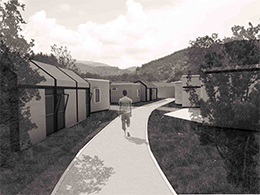STUDENTS PROJECTS
PROJECTS2013

26 May, 2015
PRISON-OFF. Juvenile Detention Center
Rural juvenile detention center in Silimna Arcadia.
Students : Veatriki Gavrielatou, Eleni Gklinou, Afroditi Manakou
Supervisor professor : Paka Alkmini
Aristotle University of Thessaloniki
Presentation date : 4 October 2014
Dealing with the issue of prisons was launched by our desire to understand the role and position of architecture, in case where the spatial production and organization function as an expression of limit.
Through the form of the whole and focusing on the feeling of communal coexistence, we attempt to create an appropriate field for the detention center to fulfill its objective functional purpose.
The open prison is the result of a gradual flexibilisation of the framework of penal sentence which usually runs parallel to the course of the prisoner towards his/her release. The "openness" lies mainly in the lack of material and natural barriers against escapes, as well as the level of trust shown to the prisoner. The study of 9 open prison examples [refer to reasearch thesis "Open Prison: A socio-spatial approach by V. Gavrielatou and E. Gklinou], led to substantial conclusions that concern the spatial organization of an open prison and the architectural interpretation of institution notions of the term.
Concepts and notions that traditionally concern architecture, such as the management of the limit, inside and outside, private and public, are of paramount importance, since their adequate manipulation suggests spaces, and thereby conditions for the functional efficienct of the open prison institution.

A notion equivalent of the open prison in Greece is encountered with in the case of rural prisons. After meticulous study of the Greek correctional system, one can observe that rural detention facilities underperform. More specifically, in the case of young prisoners (18-25 years old), who are unable to break the vicious cycle of imprisonment, the situation appears to be even worse.
Consequently, the present work is directed to the design of a Special Rural Juvenile Detention, in the province of Arcadia, in the village Silimna. Based on the fundamental pillars of a functioning penitentiary (productivity - employment - education), the model of this prison is organized according to the character of a pilot village, where prisoners are to be principally engaged in the cultivation and experimentation in the thematic of aromatic medicinal plants in areas inside and outside of the prison area.


The spatial organization proposal, in the architectural scale, sets a main axis of a tripartite structure, which is already distinguished in the building program, and at the same time takes advantafe of the dynamic geomorphology that the site presents: three different "receptors" for each subsection. The "pass", the "plateau" and "hug" are transformed into motion, public dimension and privacy and subsequently into input process, a center of public character and residential center respectively. Moreover, the natural spatial qualities, are taken into serious account and are highlighted, so as to provide -in conjunction with the organization and the character of the building infrastructure- an understandable and proper tour of the facility, with constant alternation of images, textures and qualities.
The trigger of the prison's spatial organization lies in the creation of a clear motion network, either uttering or framed by the nuclei of primary and secondary activities, supplemented with gardens and rural areas where the prisoners work

The administrative core, placed at the entrance of the prison, hosts uses that bring together the prisoner with part of his old social life: it constitutes of a visiting area and cafeteria, together with the necessary administrative uses.

Moving forward to the main prison site, the operating contains everyday uses: catering, leisure, work and education take place in this region, creating structured subunits and assembly areas, favoring the development of the detainees' social identities.

The largest area is covered by the residential center, which is developed around one of elemental branches of the main access. The starting point and concern to create a community feeling, the complex is organized as a small village. The spatial organization models that can be seen in traditional Greek villages, processed and critically reproduced: the house, the yard, the neighborhood, the central square of the village, the loose but cohesive circulation network, the complexity of the fronts arising as a result of small retreats or protrusions of the facades, are the triggers of our design. The privacy core of each prisoner, the cell, is multiplied and organized around a central volume of everyday use, thus forming a collective habitation module, built around a patio-yard. These modules, that host 11-12 people, have combined entrances in groups of 2 or 3. The total of these units, together with the housing units of our "free" prisoners (prisoners with good behavior who possess themselves the keys of their homes) in the western part of the central passage, clearly define a public place, containing a lounge for the prisoners, with the corresponding outdoor space. The variety of spaces created, follows a variation in the range of private-public, collective-individual, open-closed, offers the appropriate realm for the prisoner's adaptation to a new climate of collegiality, community and cooperation. To conclude, all construction material are summarized in the use of coated cement board, metal and glass, giving a light and reversible character of the whole operation.


Related articles:
- Penitentiary architecture ( 23 February, 2011 )
- A different physical layout of prison facilities ( 29 September, 2012 )
- re-N.E.W. the PRISON ( 20 December, 2014 )
- Alternative correctional facility in Volos ( 05 June, 2015 )
- Women’s jail precint ( 25 June, 2015 )










